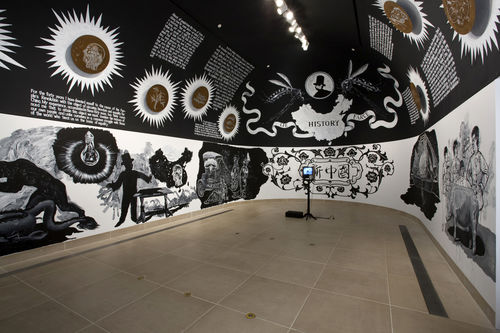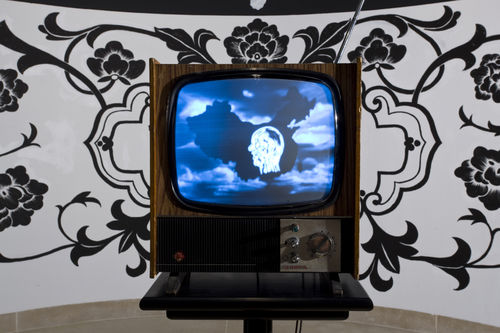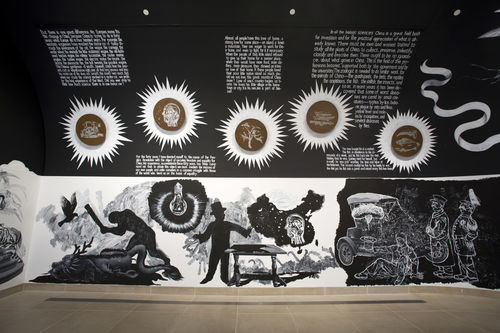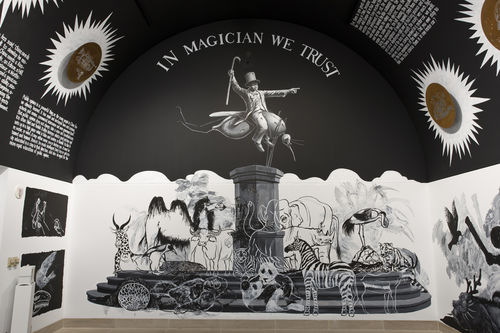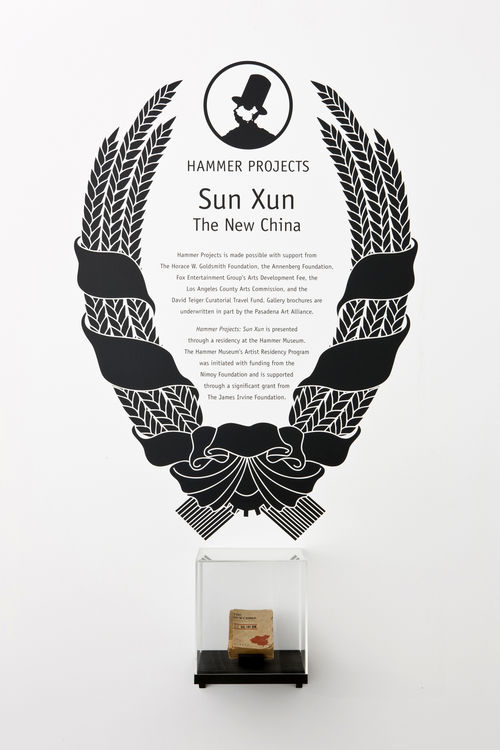
Hammer Projects: Sun Xun
- – This is a past exhibition
Sun Xun, a Chinese artist born in 1980 and living in Hangzhou, creates animations that combine hand-drawn renderings and traditional materials with new media. He studied printmaking at the China Academy of Fine Arts, but a burgeoning interest in moving images led him to found his own animation studio in 2006. To create his meticulous animations, Sun Xun produces a multitude of drawings that incorporate text within the image. His subjects range from elements found in world history and politics, to natural organisms. He then films the drawings, sequentially one at a time, to create a sense of movement and suggest the passing of time, the machinations of history, and the beauty inherent in simple forms. For over a week, Sun Xun inhabited the Vault Gallery to develop a new animated, site-related video and drawing installation.
Organized by Hammer adjunct curator James Elaine.
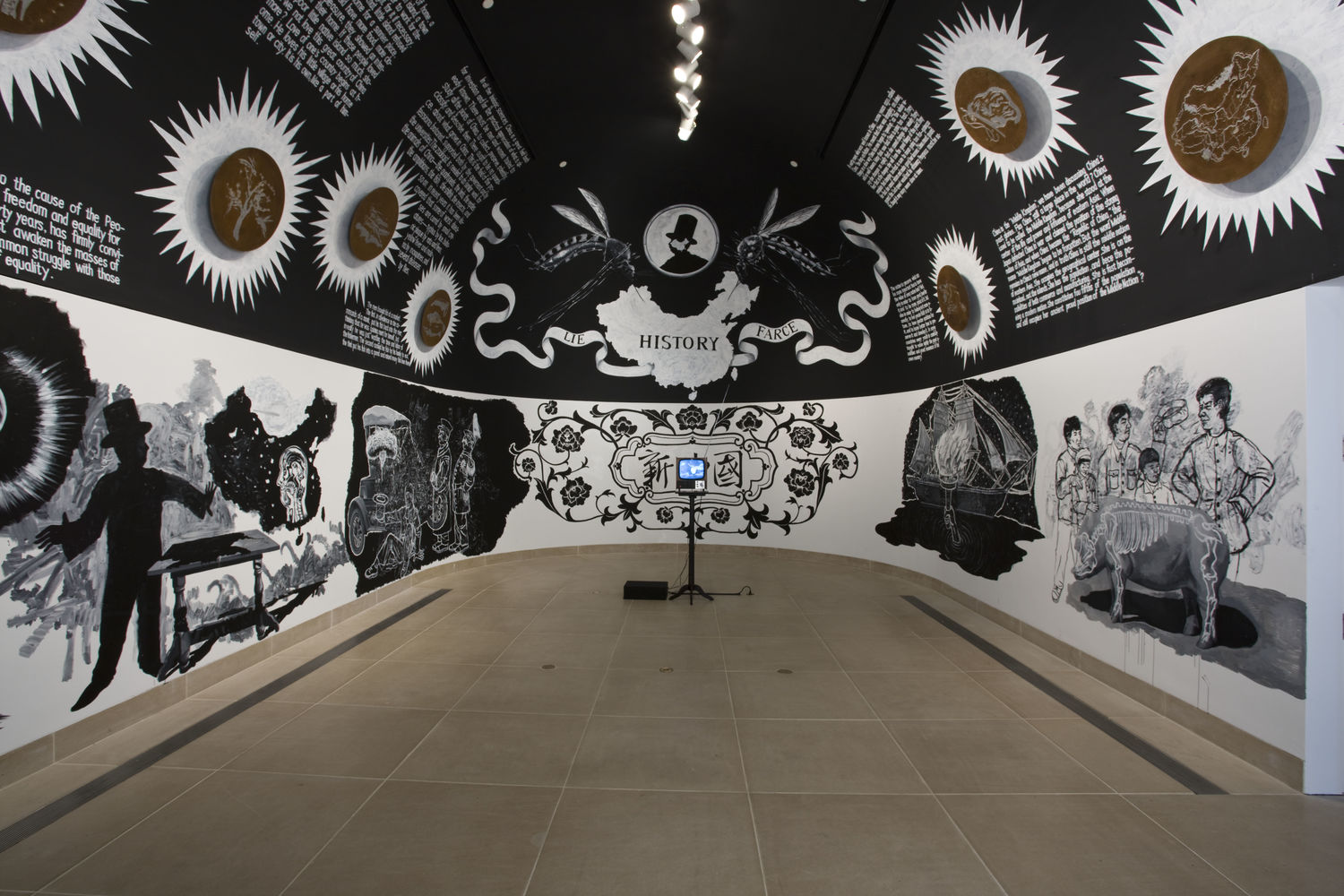
Biography
Sun Xun was born in 1980 in Fuxin, Laioning Province, China, and lives in Hangzhou, where he studied at the China Academy of Fine Arts, Hangzhou, China. In 2006 he founded Pi, his animation studio. His films have been screened at numerous festivals, including, in 2007 alone, the 25th Torino Film Festival, Torino, Italy; the 8th Seoul International Film Festival; the 53rd International Short Film Festival Oberhausen, Germany, and the MECAL International Short Film Festival, Barcelona, Spain. Sun Xun's work was recently included in China Power Station: Part II at the Astrup Fearnley Museum of Modern Art, Oslo, Norway, and his work has also been exhibited at the ShanghART and the Duolun Museum of Modern Art in Shanghai, among many other institutions throughout China. This is Sun Xun's first exhibition in an American museum.
Essay
By Mathieu Borysevicz
President Richard Nixon's 1972 visit to the People’s Republic of China marked the first time that an American president had set foot in a nation that considered the United States one of its biggest enemies. For eight days and nights, American television audiences tuned in to a dazzling parade of images from this undiscovered country, the first they had seen in more than twenty years. Following decades of cold war polemics, the visit was trumpeted as a diplomatic milestone—“The week that changed the world,” Nixon himself proclaimed—yet in China, where the masses had little access to the pristine seduction of the televised image, it was a brief distraction from domestic hardship and capitalist-bashing. Different times, places, politics, and, perhaps most importantly, media necessitate the production and consumption of different histories.
Eight years of Cultural Revolution after Nixon’s historic visit, Sun Xun was born in Liaoning Province, along the northeast coast of China. While most of the country was once again in the throes of reinventing itself—this time along the tenets of Deng Xiaoping’s economic reform and opening-up policies, which declared, “to get rich is glorious”—the new country that Sun grew up in was essentially the same old country. The effects of China’s momentous shift from socialism to capitalism were slow in coming to this peripheral mining county, and so Sun was raised in the folds of a historical lapse. Propaganda still blared from loudspeakers every morning, bringing the factory complex where he grew up to attention, just as it had done for the past few decades. Uniformed workers shuffling against chimney stacks and fluttering flags colored the environment of Sun's childhood, as did reams of newspapers that disseminated the same good word of an altogether “New China” still in its infancy. Society was changing quickly, but the official mode for dealing with it was not. The same party voice propagated the same message but had little resonance in this new context. And so while the scattered visual remnants of totalitarianism planted the seeds for Sun’s work, this environment of defective historicity helped to form its allegorical roots.
Sun Xun's work plies the uncontested surface of politicized truth. By tying together the tenets of academic drawing with political cartoons and projecting them into the realms of installation and film, he manifests his multifaceted imagistic world as improvisational theater. His broken narratives, peopled with pedagogues as magicians and infectious insects that plague the world, work on the viewer's emotional response to fear—fear of the unknown, of the undiscovered country that Shakespeare, Nixon, and each of us cower before. But it is the ambiguous era in which he sets his stories that further mystifies the viewer. Sun's world lies suspended in anonymous twentieth-century eternity, a past riddled with legacies of modernity at its most extreme, a film noir testimony to absolutism. His flickering images crystallize into a gritty, dystopic urban overture to revolution; it is the industrial revolution as much as it is the Cultural Revolution. But Sun's work, muddled in this overlapping and obsolete modernity, idles at the brink of revolution without spilling over. His aim is to scratch the surface of political history, a history continuously conflated into myth, in order to expose the past as being in a state of constant becoming. His vision is the pregnant pause of mythology in the making.
The collage that results from postmodernism's “crisis of historicity,” in which recorded events are confounded by the pastiche of existing juxtapositions, is Sun Xun's allegorical enterprise. Perhaps Sun's suspicion of mediated truth comes with the territory. The China that he grew up in was in a constant state of reinvention and denial. Moving hastily from socialist bankruptcy toward economic salvation, much of the population hasn't had the opportunity to fully process the onslaught of novelty that they continue to experience. The physical, social, and cultural transformations of this New China have created a paradox wherein nostalgia for the way things were is continually negated by the continually new, and where the ideological imprint left by Mao has yet to be adequately filled. When Sun was still in grade school, the “East Is Red” changed its tune to “Balls under the Red Flag” as the end of the 1980s saw the shock of yet another China.1 Taking the seventy-year anniversary of the May Fourth Movement (instigators of the twentieth-century's original “New China”) as their cue, students occupied Tiananmen Square in an effort to reform what they saw as a government out of step with the current needs of society.2 The outcome of this standoff was yet another New China, which violently crushed individual liberties while simultaneously promoting individual wealth and unbridled consumerism. Today China is intoxicated with its newfound prosperity but has yet to confront its recent past, revise its politics, or fulfill the spiritual needs of its people. In the wake of this erratic social transformation, a sense of collective historical amnesia has begun to set in. Sun's work is an expression of this amnesia.
A history buff with a tendency to collect printed matter, Sun Xun was given a bilingual turn-of-the-century publication, The New China.3 This book, ironically written by an American during his ten-year stay in the Republic of China, outlines a dogma of how the Chinese should behave in a world that was to become increasingly globalized. Originally employed as a tool for cultivating a new sense of nationalism, this doctrine is hauntingly similar to ones employed later by Mao at the outset of Communist liberation or by the Red Guards during the Cultural Revolution. It is also similar to ones being employed in the schools of today's hypermodern China. While the reasons behind the dogma have changed, the principles haven't: “Love and honor your country.” Fredric Jameson, in writing about utopia, suggests that today's historical situation requires archaeologies of the future and not forecasts of the past.4 Today, in the third major power shift in modern history, wherein America's twentieth century domination has instigated an accelerating global economy and the rise of “the rest,” China sits at the helm.5 But the political signposts of today suggest a potentially different future, one in which China remains undiscovered. It is a country that prepares for a science fiction future while still blighted by forms of labor exploitation reminiscent of the industrial age. With economic socialism left in the dust, Marx's Das Kapital has become a bestseller in the nation's capital.6 Sun Xun's works express the historical schizophrenia that plagues China, a nation that is in a state of incessantly becoming new.
Notes
1. “The East Is Red” (“Dongfang Hong”) is a Cultural Revolution song that reveres Mao Zedong by equating him with the sun. “Balls under the Red Flag” (“Hongqi Xiade Dan”) is the ambiguous title of a hugely popular song and album by Cui Jian, China's “father of rock and roll,” in which he describes his generation as eggs (testicles) laid by the Red Flag of the PRC .
2. This was a movement set off when students and intellectuals rioted in Tiananmen Square on May 4, 1919, to protest China's colonial occupiers and the constraints of Confucianism in an effort to establish a distinctly independent Chinese modernity.
3. The New China was written by H. B. Graybill, a missionary and educator in China, in 1914.
4. See Fredric Jameson, Archaeologies of the Future: The Desire Called Utopia and Other Science Fictions (New York: Verso, 2005).
5. Fareed Zakaria, “Rise of the Rest,” Newsweek, May 12, 2008.
6. Joel Martinsen and Dror Poleg, “Marx, Cigarettes, and Furniture Love,” Danwei, June 22, 2006.
Mathieu Borysevicz—artist, critic, and curator—is currently Artforum's correspondent in Shanghai.
Hammer Projects: Sun Xun is presented through a residency at the Hammer Museum. The Hammer Museum’s Artist Residency Program was initiated with funding from the Nimoy Foundation and is supported through a significant grant from The James Irvine Foundation.
The Hammer Projects exhibition series is made possible with support from The Horace W. Goldsmith Foundation, the Annenberg Foundation, Fox Entertainment Group’s Arts Development Fee, the Los Angeles County Arts Commission, members of the Hammer Circle, and the David Teiger Curatorial Travel Fund.



